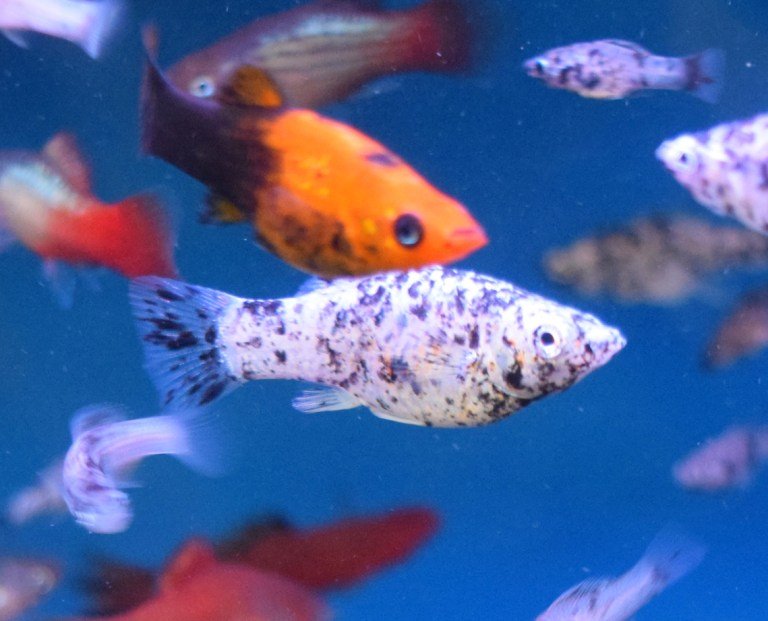
Think of your Molly fish as a little community member in your tank. Just as people can get sick, so can they. Knowing the common health problems in Molly fish and how to treat them is crucial for keeping your aquatic friend happy and vibrant. Let’s dive into the common issues you might face and explore how to tackle them effectively, so you can keep your tank flourishing.
Understanding the Signs of Illness in Mollys
Before we delve into specific health problems, it’s important to know how to recognize when your Molly might be feeling under the weather. Fish can’t tell you they’re sick, so you need to be observant. Look for changes in behavior or physical appearance.
Here are some signs that your Molly may be unwell:
- Loss of appetite: If your Molly isn’t eating, it’s a big red flag.
- Lethargy: A suddenly sluggish fish that hangs at the bottom of the tank might be ill.
- Strange swimming patterns: Erratic swimming or darting around can signal stress or illness.
- Physical changes: Look for discoloration, spots, or swelling on the body.
By keeping a watchful eye on these behaviors, you may be able to catch problems early before they escalate.
Ich (White Spot Disease)
Ich, or Ichthyophthirius multifiliis, is a common disease that Molly fish can suffer from, especially if they’re stressed or their environment isn’t ideal. It shows up as tiny white spots on the fish, almost like grains of salt clinging to their body and fins.
So, why does this happen? Often, it’s due to poor water conditions or stressors in the tank like sudden temperature changes or overcrowding. To treat Ich, you can raise the tank temperature slightly (but carefully) and add aquarium salt. You might also need to consider a medication specifically designed for Ich, available at pet stores.
The important thing is to quarantine affected fish to prevent spreading the infection. By addressing the issue quickly, you can save your Molly from severe discomfort and keep your fish tank healthy.
Fin Rot
Fin rot is another common ailment among Molly fish. It usually makes the fins look ragged or discolored, almost as if they’re falling apart. This condition often arises from poor water quality or injuries, and it can be frustrating to deal with.
To treat fin rot, it’s crucial to first improve the tank’s water quality. Regular water changes, using a good filter, and monitoring the water parameters (like ammonia, nitrite, and nitrate levels) are essential steps. You can also treat fin rot with anti-bacterial medications available at pet stores.
Strengthening your Molly’s immune system with a high-quality diet can also help in recovery. After all, a healthy fish is better equipped to fight off infections!
Swim Bladder Disorder
Have you noticed your Molly having trouble swimming? Perhaps it’s floating at the top or hanging at the bottom. This behavior could indicate swim bladder disorder, which affects the fish’s buoyancy.
Several factors can contribute to this issue, including overfeeding, poor water conditions, or constipation. To help your Molly, consider fasting it for a day or two and then feeding it some blanched peas. This can help get things moving in its digestive system. If swimming issues persist, it’s advisable to check the water quality and ensure everything’s in line.
Sometimes, swim bladder disorder can be complicated. If simple fixes don’t work, consulting a veterinarian who specializes in fish might be necessary.
Columnaris
Columnaris is a bacterial infection that can affect Molly fish, leading to lesions, frayed fins, and even lethargy. This condition often arises in tanks with poor water quality or stress. Thankfully, it is treatable if caught early.
To address columnaris, start by improving water conditions. You can also use antibiotics specific to this infection. It’s vital to ensure the tank is clean and that the fish are not stressed. Monitor your Molly closely; early intervention can help prevent serious complications.
Preventing Health Problems in Molly Fish
Prevention is always better than cure. Maintaining a healthy environment for your Molly is key to avoiding many health problems. Here are some practical tips to keep your fish in tip-top shape:
- Regular water changes: Change 20-30% of the water every week to keep it fresh.
- Test water parameters: Use a water testing kit to keep an eye on pH, ammonia, and nitrate levels.
- Feed a balanced diet: A varied diet helps boost your Molly’s immunity.
- Avoid overcrowding: Ensure your tank has enough space for your fish to thrive.
These simple practices can go a long way in preventing illnesses and ensuring a happy environment for your Molly.
When to Seek Professional Help
Sometimes, despite our best efforts, a Molly might need professional help. If you notice persistent symptoms, such as not eating, severe fin damage, or unusual swimming patterns, it’s time to consult a veterinarian with experience in fish.
Keep in mind that early intervention is key. The sooner you get a professional opinion, the better the chances of recovery. Many fish keepers have successfully treated their pets by seeking the right help when needed.
Caring for a Molly fish can be incredibly rewarding, but it comes with responsibilities. By understanding the common health problems they face and how to treat them, you take a crucial step toward ensuring they live a long and healthy life. Remember, monitoring their behavior and maintaining a clean, stable environment can prevent many issues before they start. So, keep those eyes peeled, and your Molly will surely flourish in its aquatic home!

